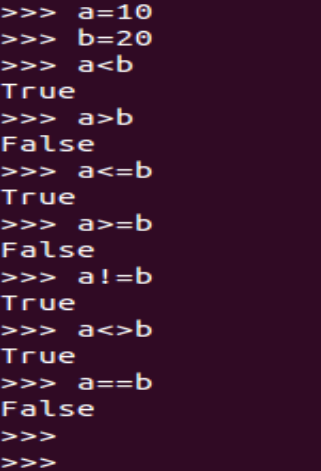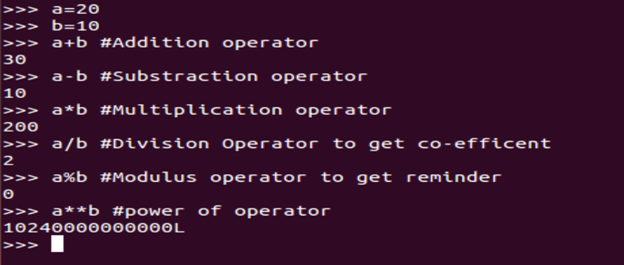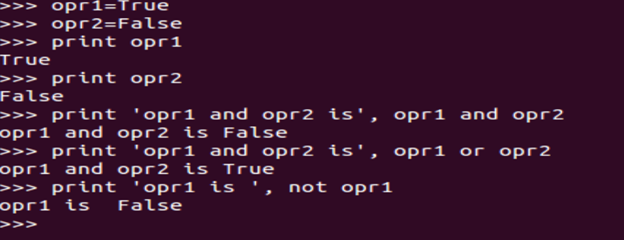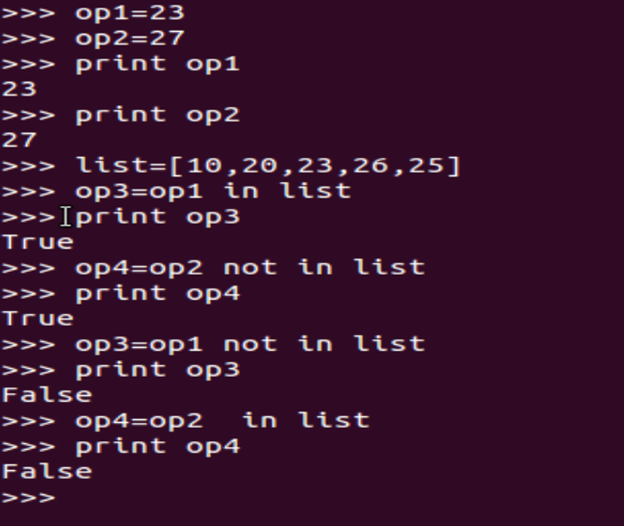PREV NEXT
- Operators are very familiar with basic mathematics.
- Operator is nothing but performing the specific operation between operands. It is called the operator.
Operator classification:
- Operators can be classified based on the operations that they perform or based on the number of operands it operates on.
- Based on the number of operands, we can classify operators as given below.
- Unary Operator
- Binary Operator
- Ternary Operator
1. Unary Operators
The unary operators operate on a single operand. The addition, subtraction and multiplication operators are used as unary operator in python. We will discuss more about this operator below.
2. Binary Operators
A binary operator is an operator that operates on two operands.
- Arithmetic Operators
- Assignment Operators
- Relational Operators
- Logical Operators
- Membership operators
- Identity operators
- Bitwise operators
3. Ternary Operators
The ternary operator is an operator that operates on three operands. The first argument is an expression, If expression is true then second argument will execute else third argument will execute.
Conditional Operators:
Now, we are going in detail of all operators one by one.
1. Arithmetic Operators:
| Operator / Meaning | example |
| + (To perform Addition) | 23+33=56 |
| – (To perform subtraction) | 33-23=10 |
| * (To perform Multiplication) | 10*20=200 |
| / (To perform Division (To get the co-efficient)) | 20/10=2 |
| % (Modulus (To get the reminder)) | 5%4=1 |
| ** (exponent operator(power of)) | 2**3=8 |
2. Assignment Operators:
- Assignment operator is used to assign value to a variable (memory location). It evaluates expression on right side of = symbol and assigns evaluated value to left side the variable.
- The RHS of assignment operator must be a constant, expression or variable. Whereas LHS must be a variable (valid memory location).
Example:
|
1 2 3 4 5 6 7 8 9 |
a=10 b=20 a=b x=24.6 y=”hi” |
Shorthand assignment operator:
Python supports a short variant of assignment operator called compound assignment or shorthand assignment operator. Shorthand operator combines one of the Arithmetic operator or bitwise operator
There are many ways of using the short hand operator. They are listed below.
| Shorthand assignment operator / Example | Meaning |
| += Example: a+=5 | a=a+5 |
| -= Example: a-=5 | a=a-5 |
| *= / a*=5 | a=a*5 |
| /= / a/=5 | a=a/5 |
| %= / a%=5 | a=a%5 |
| &= / a&=5 | a=a&5 |
| |= / a|=5 | a=a|5 |
| ^= / a^=5 | a=a^5 |
| ~= / a~=5 | a=a~5 |
| <<= / a<<=5 | a=a<<5 |
| >>= / a>>=5 | a=a>>5 |
3. Relational Operators:
Relational operator is nothing but an operator which defines some kind of relationship between two entities or two objects or two variables.
| Operator | Description |
| < | Less than |
| > | Greater than |
| <= | Less than equal to |
| >= | Greater than equal to |
| == | Equal to |
| != | Not equal to |
| <> | Not equal to |
Example:

4. Logical Operators:
- Logical operators are mainly used to control program flow
- The concept of logical operators is simple.
- In logical AND operator, if any one operand is false then result is false else result is true
- In logical OR operator, if any one operand is true then result is true else result is false
- In logical NOT operator, it will work on single operand, if operand is true result is false else vice versa
Logical operator is divided as below.
| Operators | Meaning |
| and | Logical AND, if both operands are true then result is true |
| or | Logical OR, if one operand is true then result is true |
| not | if operand true, then result is false |
Truth table for Logical AND
| Operand1 / Operand2 | Output |
| False / False | False |
| False / True | False |
| True / False | False |
| True / True | True |
Truth table for Logical OR
| Operand1 / Operand2 | Output |
| False / False | False |
| False / True | False |
| True / False | False |
| True / True | True |
Truth table for Logical NOT
| Operand1 | Output |
| False | True |
5. Membership Operator:
- The membership operator is a special operator introduced in python programming language
- It is used to validate the membership of value
- It is used to test the membership in sequence data types like list, tuples, and strings
| Operator | Meaning |
| In | The ‘in’ operator is used to check if a value exists in a sequence or not. Evaluates to true if it finds a variable in the specified sequence and false otherwise. |
| not in | This operand is used to find the variable which are not existing other than the values given in the sequence. |
6. Identity operators:
This operator is used identify type of the object, variable etc. There are different identity operators such as,
| Opearator | Meaning |
| Is | Evaluate true if identity of two operands are same, else false |
| is not | Evaluate false if identity of two operands are same, else true |
Example:
|
1 2 3 4 5 6 7 8 9 10 11 12 13 14 15 16 17 18 19 20 21 |
x=42 y=42 if ( x is y): print "both are same identity" else: print "both are different identity" y=35 if ( x is not y): print "both are different identity" else: print "both are same identity" |
Output:
| both are same identity both are different identity |
7. Bitwise operators:
Bitwise operator is working on 0 and 1’s and manipulate the bits, it will give the performance wise very well. Bitwise operation scripting is very helpful in hardware level programming.
Consider inputs are a=10 ( 1010 ) and b=6 (0110)
| Operator Symbol / Name / Desciption | Example / Output |
| & ( Binary AND – If all bits are 1,then output 1 ) | (a & b) (1010 & 0110) / 0010 |
| | ( Binary OR – If any one bits is 1,then output 1 ) | (a | b) (1010 | 0110) / 1110 |
| ^ ( Binary XOR – If all bits are 1 or 0,then output 1 ) | (a ^ b) (1010 ^ 0110) / 0001 |
| ~ ( Binary Complement – It compliment operator,like logical not ) | (~a ) (~(1010)) / 0101 |
| << ( Binary Left Shift – It will shift to left no.of bits ) | a << 1 ((1010) << 1) / 0100 |
| >> ( Binary Right Shift – It will shift to right no.of bits ) | a >> 1 ((1010) >> 1) / 0101 |



